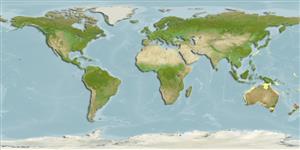Issue
Gender agreement to be confirmed, niver vs nigra.
Environment: milieu / climate zone / depth range / distribution range
Ecologia
marino; salmastro demersale. Subtropical
Southwest Pacific: eastern Australia.
Size / Peso / Age
Maturity: Lm ? range ? - ? cm
Max length : 35.0 cm TL maschio/sesso non determinato; (Ref. 9002)
Short description
Chiavi di identificazione | Morfologia | Morfometria
Spine dorsali (totale) : 0; Raggi dorsali molli (totale) : 56 - 62; Spine anali: 0; Raggi anali molli: 44 - 52. Caudal fin rounded; pectorals small (Ref. 33839). Eyed side uniformly blackish or light brown with large patches of dark brown cirri, pectoral fin nearly black, dorsal, anal and caudal fins with narrow whitish margin; blind side creamy to white with brownish pigment on unpaired fins, pectorals whitish, lower portion blackish in some large specimens (Ref. 33839).
Occurs in muddy bottoms of coastal rivers, estuaries and shallow inshore waters (Ref. 33839). Flesh is of excellent quality (Ref. 33839).
Life cycle and mating behavior
Maturities | Riproduzione | Spawnings | Egg(s) | Fecundities | Larve
Gomon, M.F., C.J.M. Glover and R.H. Kuiter (eds.), 1994. The fishes of Australia's south coast. State Print, Adelaide. 992 p. (Ref. 33839)
IUCN Red List Status (Ref. 130435)
Threat to humans
Harmless
Human uses
Pesca: scarso interesse commerciale
Strumenti
Special reports
Download XML
Fonti Internet
Estimates based on models
Preferred temperature (Ref.
123201): 17 - 24.9, mean 19.6 °C (based on 92 cells).
Phylogenetic diversity index (Ref.
82804): PD
50 = 0.5000 [Uniqueness, from 0.5 = low to 2.0 = high].
Bayesian length-weight: a=0.00977 (0.00473 - 0.02021), b=3.07 (2.90 - 3.24), in cm total length, based on LWR estimates for this (Sub)family-body shape (Ref.
93245).
Trophic level (Ref.
69278): 3.7 ±0.4 se; based on size and trophs of closest relatives
Resilienza (Ref.
120179): Medio, tempo minimo di raddoppiamento della popolazione 1.4 - 4.4 anni (Preliminary K or Fecundity.).
Fishing Vulnerability (Ref.
59153): Low vulnerability (25 of 100).
